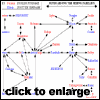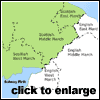
|
An Introduction to the Border Reivers Continued from Page One
by Stuart William Bird (BA (Hons) History)
The Borderers of both England and Scotland by the 16th century realised that their respective government could no longer provide justice nor protection. This is not to say the Borderers even remembered the events of 1296, but with the conflicts of the 16th century there was no need to.
It was this allegiance to clan and family, that saw the growth of the great riding surnames of the Border regions. Within the Borders ‘to ride’ became synonymous with ‘to raid’, so the great riding families were those most involved in raiding.
The emergence of the surnames and the weak sense of nationality was directly related to the wars and policies of the governments of the opposing countries. As early as the 13th century, the people living there were encouraged to raid the opposite kingdom during times of peace. With the many atrocities that occurred on the Borders during warfare little encouragement was needed. Though with the loss of national feeling the Borderers were often content in aiding in foray’s from the opposite realm.
It was not unknown for the Warden and others whose job it was to keep the peace, to become deeply involved within these feuds. The Feud Table gives some idea of the number of feuds that existed, and as can be seen by the colour key, feuds were not restricted by each names nationality, for example the Scotts are feuding with both the English Charltons, and the Scottish Elliots.
By 1296 the hostilities between England and Scotland had meant that there was a need for an office with military powers to be placed in defence of the Border. Edward I issued a commission to appoint captains and keepers for the peace, and to split the Border into Marches. At first this post was temporary and only instigated when the need arose, but by 1309 the position had become permanent, with one person in charge of each country, and became known as the Warden of the March.
By the sixteenth century the Warden, upon entering office, would be backed by Deputies, Keepers, Captains, Land Sergeants and Troopers. During the late sixteenth century the Wardens of England tended to be given to gentlemen from the southern counties. This was an attempt to avoid appointing any who had connections with the feuding factions, though with relatively little pay, many still fell foul to temptation, and became deeply involved within the corruption that was rife within the area.
This, then, is briefly how the Border reivers came into existence. By the time of Robert Carey, the Borders of England and Scotland were in considerable turmoil. Constant raiding and murder were everyday affairs throughout the Marches. The Middle March, at the time Carey was appointed Warden in 1598, had long since been in a bad state of affairs, and had suffered for reasons other than the problems outlined above, under two successive Wardens, Sir John Forster and Lord Eure. This article was printed with the permission of the author, Stuart Bird. Stuart can be reached by email at swbird@borderreivers.org.uk To read more about the fascinating world of the Border Reivers, go to Stuart's amazing website The Border Reivers at http://www.borderreivers.org.uk/ Links: |
Thursday, December 26th, 2019
Attention visitors: Tartans.com is back. Please note that this is a snapshot of the site as it existed nearly 20 years ago and you may encounter broken links; we are still combing through the site and correcting those as we find them. Please also note that some sections are currently not functional, primarily the discussion forums/clan chat boards.
|
** HOME - First Time Visitors - Glossary - - Contact Us ** Awards | Bibliography | Clan Calendar | Clan Chat | Clan Finder | History | Famous Scots | Genealogy | Great Hall of the Clans | Links | News and Features | Scots on the Net | Search | Site Map The Gathering of the Clans
Copyright 1995- Tartans.com - All Rights Reserved. |






